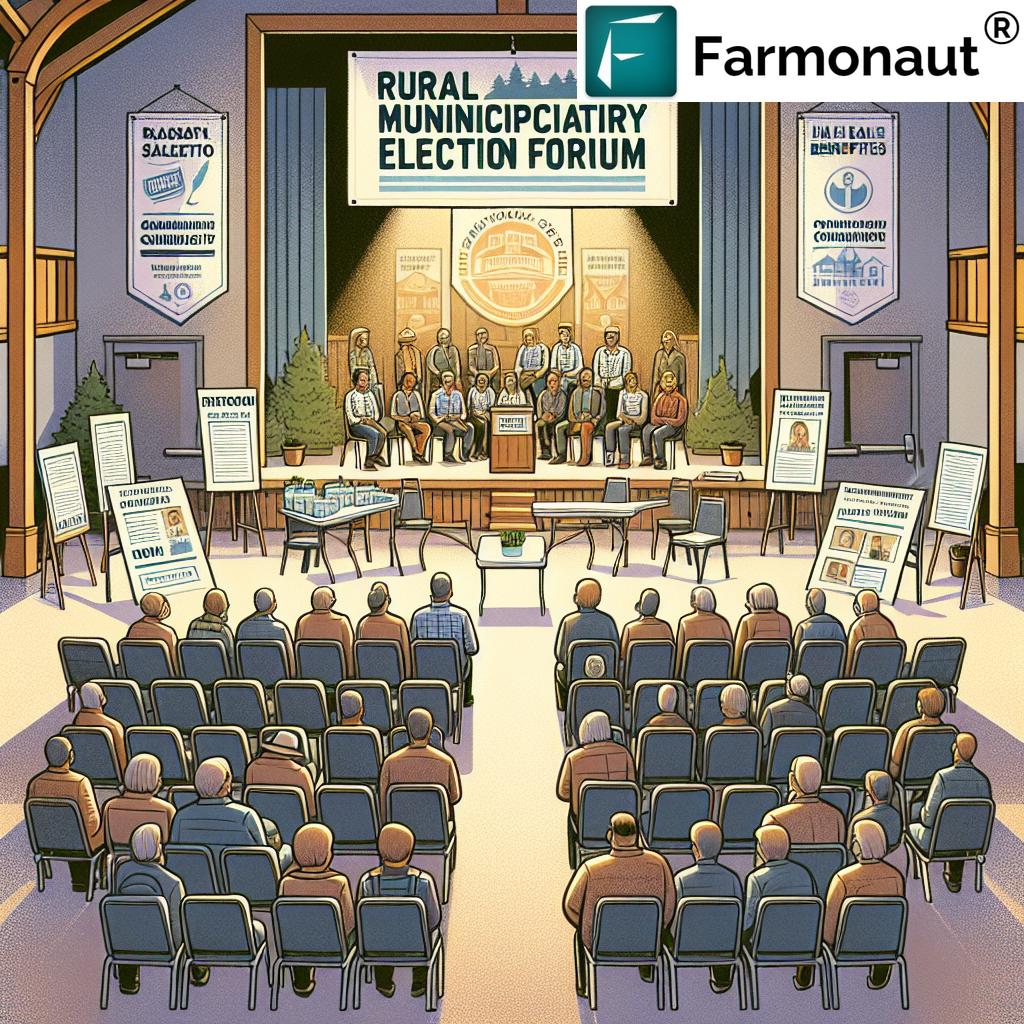Saskatchewan’s Rural Municipality Council Remuneration Overhaul: Boosting Civic Engagement and Local Governance
“86% of Saskatchewan’s municipal councillors were acclaimed in the last election, prompting remuneration policy changes.”
In the heart of Canada’s prairies, a significant shift is underway in local governance. Saskatchewan’s rural municipalities are taking bold steps to address a pressing issue that has long plagued their electoral processes. We’re witnessing a transformative moment in civic engagement as councils across the province implement substantial changes to their remuneration policies. These reforms aim to attract a more diverse pool of candidates for municipal elections and reinvigorate local democracy.
At the forefront of this movement is the Rural Municipality (RM) of Corman Park, which has recently approved a landmark decision to overhaul its council remuneration structure. This decision marks a pivotal moment in Saskatchewan’s rural governance landscape, potentially setting a precedent for other municipalities to follow.
The Catalyst for Change: Understanding the Need for Remuneration Reform
The impetus for this rural municipality council remuneration reform stems from a startling statistic: a staggering 86% of municipal councillors in Saskatchewan were acclaimed in the last election. This figure underscores a critical lack of candidate participation in local governance, raising concerns about the health of democracy at the grassroots level.
We recognize that this trend is not just a numbers game; it’s a reflection of deeper issues within the structure of local government participation. The low engagement in municipal elections can be attributed to various factors, but one stands out prominently: the inadequate compensation for the time and effort required to serve as a municipal councillor.
- Insufficient remuneration discouraging potential candidates
- Lack of diversity in council representation
- Increasing complexity of municipal governance issues
- Growing time commitments required from elected officials
To address these challenges head-on, the RM of Corman Park has taken a bold step forward. During their January 28 meeting, councillors unanimously approved significant increases in compensation, signaling a new era in municipal council salary structures.
Breaking Down the New Remuneration Structure
The changes approved by the Corman Park council are substantial and multifaceted. Let’s delve into the specifics of this rural municipality council remuneration overhaul:
- Base Pay Increase: The monthly base pay for the reeve will rise to $2,500, while councillors will receive $1,500. This marks a significant jump from the previous base pay of $620 per month.
- Meeting Rate Adjustment: The rate for attending meetings has doubled from $62 to $124, acknowledging the time investment required for council duties.
- Committee Chair Compensation: Compensation for committee chairs has nearly doubled, increasing from $26 to $50.
- Extended Health Benefits: Councillors now have the option to enroll in extended health and dental benefits provided by the Saskatchewan Association of Rural Municipalities (SARM).
- Mileage and Per Diem Adjustments: The mileage rate has been increased by five cents to 66 cents per kilometer, and the daily meal per diem for 2025 has been raised to $100.
These changes are set to take effect retroactively from January 1, 2025, demonstrating the council’s commitment to immediate action.

The Financial Implications: Balancing Cost and Benefit
While the benefits of this remuneration reform are clear, it’s crucial to acknowledge the financial implications for the municipality. The additional annual cost to implement these changes is estimated at $120,000. This represents a significant investment in local governance, one that the council believes will pay dividends in terms of improved civic engagement and more effective municipal leadership.
Division 1 Councillor John Germs encapsulated the council’s sentiment, describing the decision as a tough but necessary one. The council’s willingness to make this investment speaks volumes about their commitment to strengthening local democracy and ensuring fair compensation for public service.
Comparative Analysis: Old vs. New Remuneration Structure
To better understand the scale of these changes, let’s examine a comparative table of the old and new remuneration structures:
| Remuneration Component | Previous Structure | New Structure | Percentage Increase |
|---|---|---|---|
| Monthly Base Pay (Reeve) | $620 | $2,500 | 303% |
| Monthly Base Pay (Councillors) | $620 | $1,500 | 142% |
| Meeting Rate | $62 per meeting | $124 per meeting | 100% |
| Committee Chair Compensation | $26 | $50 | 92% |
| Extended Health Benefits | Not offered | Optional | N/A |
| Mileage Rate | $0.61 per km | $0.66 per km | 8% |
| Daily Meal Per Diem (2025) | $65 | $100 | 54% |
This table illustrates the substantial increases across various components of the remuneration package, highlighting the council’s commitment to fairly compensating elected officials for their service.
The Rationale Behind the Reform
The decision to implement these changes wasn’t made lightly. Several key factors influenced the council’s approach to remuneration reform:
- Unique Operational Context: Chief Administrative Officer Kerry Hilts emphasized that Corman Park operates in a distinctive environment due to its large area, significant population, and urban presence. This makes direct comparisons with other rural municipalities challenging.
- Evolving Roles and Responsibilities: Division 4 Councillor David Greenwood pointed out that the reeve’s role now resembles a full-time position, reflecting the increasing demands placed on elected officials.
- Competitive Compensation: Greenwood also noted that industry rates for similar roles suggest higher salaries may be necessary to attract qualified candidates.
- Community Engagement: Councillor John Saleski stressed the importance of fostering diversity in candidacy, arguing that healthy communities should see a range of individuals vying for council positions rather than unanimous acclamations.
“One rural municipality in Saskatchewan doubled meeting rates for councillors to boost civic engagement and diversity.”
The Broader Impact on Saskatchewan’s Rural Governance
While the RM of Corman Park is at the forefront of this remuneration reform, its actions are likely to have ripple effects across Saskatchewan’s rural municipalities. We anticipate that other councils may follow suit, recognizing the need to reevaluate their own compensation structures to remain competitive and attract diverse talent.
This shift in remuneration policy could potentially transform the landscape of rural governance in Saskatchewan by:
- Encouraging a wider range of candidates to consider running for municipal office
- Improving the retention of experienced councillors
- Enhancing the quality of local governance through more engaged and diverse councils
- Addressing the issue of widespread acclamations in municipal elections

Challenges and Considerations in Implementing Remuneration Reform
While the potential benefits of this remuneration overhaul are significant, it’s important to acknowledge the challenges and considerations that come with such a substantial change:
- Budgetary Constraints: Municipalities must carefully balance the increased cost of remuneration with other budgetary needs and constraints.
- Public Perception: There may be concerns from residents about the increased expenditure on council salaries, necessitating clear communication about the rationale and expected benefits.
- Equity Across Municipalities: As different municipalities adopt varying levels of remuneration, there may be concerns about equity and competition between neighboring areas.
- Performance Metrics: With increased compensation comes heightened expectations. Municipalities may need to develop robust performance metrics to ensure accountability.
- Long-term Sustainability: Councils must consider the long-term financial sustainability of these increased remuneration packages.
The Role of Provincial Government and SARM
As rural municipalities in Saskatchewan navigate these changes, the role of the provincial government and organizations like the Saskatchewan Association of Rural Municipalities (SARM) becomes increasingly important. These bodies can provide guidance, support, and potentially standardized frameworks to ensure consistency and fairness across the province.
Key areas where provincial involvement could be beneficial include:
- Developing provincial guidelines for municipal council remuneration
- Providing resources and training for councils on governance best practices
- Facilitating knowledge sharing between municipalities on remuneration strategies
- Monitoring the impact of remuneration changes on election participation and governance quality
Looking to the Future: Potential Outcomes and Expectations
As we look ahead, the potential outcomes of this rural municipality council remuneration overhaul are both exciting and challenging. We anticipate several key developments:
- Increased Candidate Diversity: With more attractive compensation packages, we expect to see a broader range of candidates, including younger professionals and individuals from diverse backgrounds, stepping forward to run for council positions.
- Enhanced Council Performance: Higher remuneration may lead to more dedicated council members who can commit more time and resources to their roles, potentially improving the overall quality of local governance.
- Greater Public Engagement: As the profile of council positions is elevated, there may be increased public interest in municipal affairs, leading to higher voter turnout and more active community participation.
- Policy Innovation: More diverse and engaged councils could lead to innovative policy solutions tailored to the unique needs of rural Saskatchewan communities.
- Potential Challenges: There may be initial resistance or skepticism from some community members regarding the increased costs. Councils will need to clearly communicate the benefits and demonstrate value through improved governance.
The Importance of Monitoring and Evaluation
As rural municipalities in Saskatchewan embark on this new path, it will be crucial to implement robust monitoring and evaluation processes. These should aim to:
- Track changes in candidate numbers and diversity in future elections
- Assess the impact on council performance and decision-making
- Measure public satisfaction with local governance
- Evaluate the financial sustainability of the new remuneration structures
- Compare outcomes across different municipalities to identify best practices
Conclusion: A New Chapter in Saskatchewan’s Rural Governance
The rural municipality council remuneration overhaul in Saskatchewan represents a bold step towards reinvigorating local democracy and enhancing the quality of rural governance. By addressing the long-standing issue of inadequate compensation for elected officials, municipalities like Corman Park are paving the way for a more engaged, diverse, and effective system of local government.
While challenges remain, the potential benefits of this reform are significant. As we move forward, it will be essential for all stakeholders – from elected officials and municipal administrators to provincial bodies and community members – to work together in ensuring the success of this initiative.
The coming years will be crucial in determining the long-term impact of these changes. Will we see a surge in candidate participation? Will the quality of local governance improve? Only time will tell. However, one thing is clear: Saskatchewan’s rural municipalities are taking proactive steps to address the challenges of modern governance, setting an example that may well be followed by other regions across Canada and beyond.
As we continue to monitor these developments, we remain optimistic about the future of rural governance in Saskatchewan. This remuneration reform could very well mark the beginning of a new era of civic engagement, diverse representation, and innovative local leadership in the province’s rural municipalities.
FAQs about Saskatchewan’s Rural Municipality Council Remuneration Overhaul
- Q: Why was this remuneration overhaul necessary?
A: The overhaul was necessary due to the low participation in municipal elections, with 86% of councillors being acclaimed. The increased remuneration aims to attract a more diverse range of candidates and improve civic engagement. - Q: How much will the new remuneration structure cost the municipality?
A: The additional annual cost to implement these changes is estimated at $120,000 for the RM of Corman Park. - Q: When will these changes take effect?
A: The changes are set to take effect retroactively from January 1, 2025. - Q: Will all rural municipalities in Saskatchewan adopt similar changes?
A: While the RM of Corman Park has taken the lead, it’s anticipated that other municipalities may follow suit, though each will make decisions based on their specific circumstances. - Q: How will the success of this remuneration reform be measured?
A: Success will likely be measured by factors such as increased candidate participation in future elections, improved council performance, and enhanced public engagement in municipal affairs.
As we conclude our analysis of Saskatchewan’s rural municipality council remuneration overhaul, it’s worth noting that innovations in local governance often go hand in hand with technological advancements in various sectors, including agriculture. For those interested in exploring cutting-edge solutions for farm management and agricultural productivity, we recommend checking out Farmonaut’s suite of tools and services.
Explore Farmonaut’s innovative agricultural solutions:
For developers interested in integrating agricultural data into their own applications, Farmonaut offers a robust API:
Earn With Farmonaut: Affiliate Program
Earn 20% recurring commission with Farmonaut’s affiliate program by sharing your promo code and helping farmers save 10%. Onboard 10 Elite farmers monthly to earn a minimum of $148,000 annually—start now and grow your income!
By leveraging technologies like those offered by Farmonaut, rural municipalities can not only improve their governance structures but also support their agricultural communities with state-of-the-art farm management tools.
















